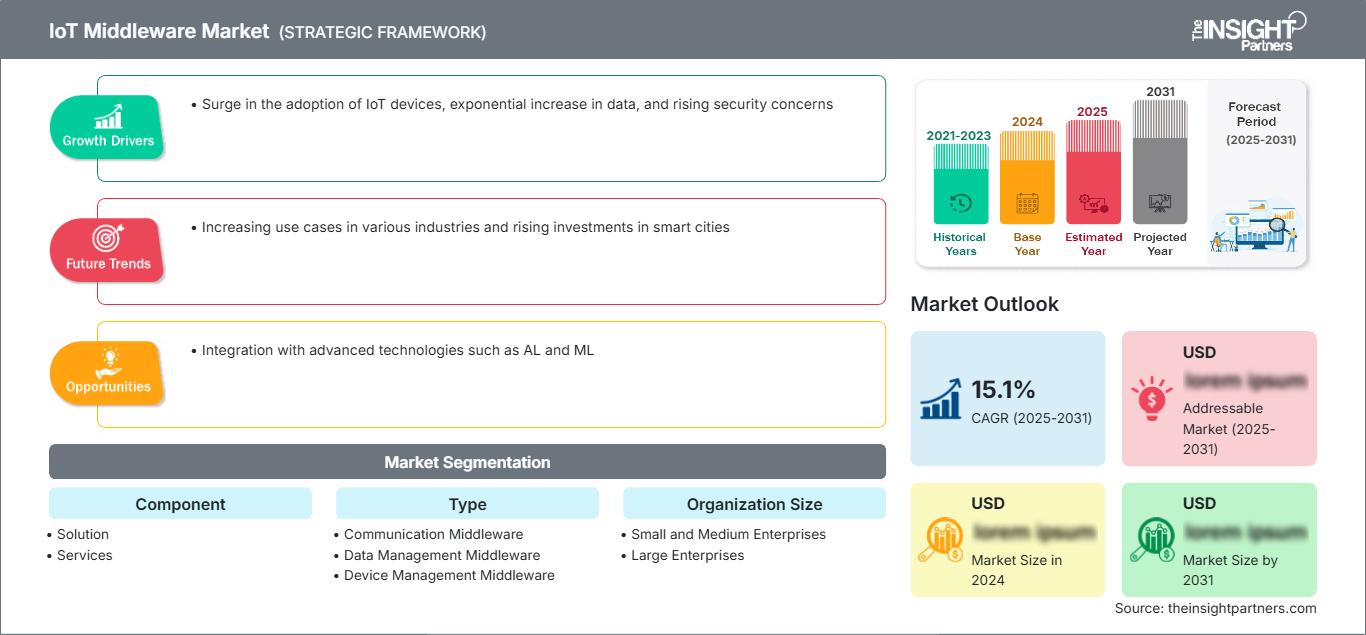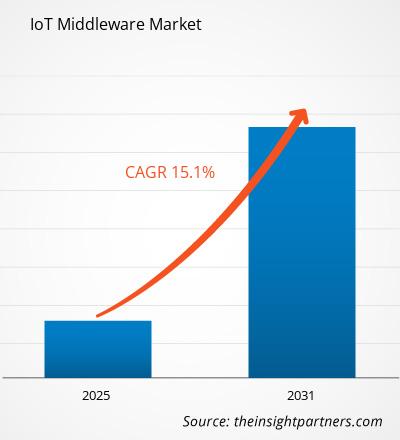Si prevede che il mercato del middleware IoT registrerà un CAGR del 15,1% nel periodo 2023-2031. L'integrazione con tecnologie avanzate come AL e ML è destinata a rimanere una tendenza chiave nel mercato.
Analisi del mercato del middleware IoT
- Il mercato del middleware IoT presenta prospettive di crescita dovute alle attuali tendenze del mercato e al loro impatto prevedibile durante il periodo di previsione.
- Il mercato del middleware IoT è in crescita a causa di fattori quali l'aumento dell'adozione di dispositivi IoT, l'aumento esponenziale dei dati e le crescenti preoccupazioni in materia di sicurezza.
- L'aumento dei casi d'uso in vari settori e l'aumento degli investimenti nelle città intelligenti offrono opportunità redditizie per il mercato del middleware IoT.
Panoramica del mercato del middleware IoT
- Il middleware IoT è un software che opera in un sistema Internet of Things (IoT) tra i livelli hardware e applicativo.
- Offre una gamma di servizi e funzionalità per facilitare la comunicazione e l'interazione tra varie piattaforme, dispositivi e applicazioni IoT.
- Il middleware IoT è essenzialmente il collante che collega diversi componenti di un sistema IoT, consentendo loro di interagire senza soluzione di continuità. Il middleware IoT svolge un ruolo cruciale nello sviluppo e nell'implementazione di applicazioni IoT.
- L'integrazione, l'interoperabilità e l'amministrazione di diverse piattaforme, dispositivi e app IoT sono rese possibili dalla gamma di servizi e funzionalità offerti dal middleware IoT.
Personalizza questo rapporto in base alle tue esigenze
Potrai personalizzare gratuitamente qualsiasi rapporto, comprese parti di questo rapporto, o analisi a livello di paese, pacchetto dati Excel, oltre a usufruire di grandi offerte e sconti per start-up e università
Mercato del middleware IoT: Approfondimenti strategici

- Ottieni le principali tendenze chiave del mercato di questo rapporto.Questo campione GRATUITO includerà l'analisi dei dati, che vanno dalle tendenze di mercato alle stime e alle previsioni.
Driver e opportunità del mercato del middleware IoT: l'adozione di dispositivi IoT favorisce il mercato
Potrai personalizzare gratuitamente qualsiasi rapporto, comprese parti di questo rapporto, o analisi a livello di paese, pacchetto dati Excel, oltre a usufruire di grandi offerte e sconti per start-up e università
Mercato del middleware IoT: Approfondimenti strategici

- Ottieni le principali tendenze chiave del mercato di questo rapporto.Questo campione GRATUITO includerà l'analisi dei dati, che vanno dalle tendenze di mercato alle stime e alle previsioni.
- Con la continua evoluzione dei dispositivi IoT, l'importanza del middleware nella gestione e nell'estrazione di informazioni dai dati IoT crescerà ulteriormente.
Casi d'uso crescenti in vari settori
- Investire nello sviluppo di piattaforme middleware IoT può essere fondamentale per le aziende che operano in diversi settori. Le piattaforme middleware IoT nel settore manifatturiero facilitano l'integrazione di sistemi industriali, macchinari e sensori.
- Rendono possibile la manutenzione predittiva, il monitoraggio delle apparecchiature in tempo reale e l'ottimizzazione dei processi di produzione. In ambito produttivo, possono migliorare l'efficienza complessiva, semplificare le operazioni e ridurre i tempi di inattività.
- La piattaforma middleware IoT nel settore sanitario aiuta a gestire dispositivi medici, dati dei pazienti e sistemi sanitari. Aiuta gli operatori sanitari a prendere decisioni rapide, garantisce uno scambio sicuro di dati tra i sistemi sanitari e consente il monitoraggio remoto dei pazienti.
- Inoltre, può migliorare i risultati per i pazienti, ottimizzare l'utilizzo delle risorse e migliorare l'assistenza ai pazienti.
Analisi della segmentazione del rapporto di mercato del middleware IoT
I segmenti chiave che hanno contribuito alla derivazione dell'analisi di mercato del middleware IoT sono componente, tipo, dimensione dell'organizzazione e verticale.
- Per componente, il mercato è suddiviso in soluzioni e servizi.
- Per tipo, il mercato è segmentato in middleware di comunicazione, middleware di gestione dei dati, middleware di gestione dei dispositivi e middleware di sicurezza.
- Per dimensione dell'organizzazione, il mercato è suddiviso in piccole e medie imprese e grandi imprese.
- Per verticale, il mercato è segmentato in IT e telecomunicazioni, governo e difesa, vendita al dettaglio e e-commerce, produzione, BFSI e altri.
Analisi della quota di mercato del middleware IoT per area geografica
- Il rapporto sul mercato del middleware IoT comprende un'analisi dettagliata di cinque principali regioni geografiche, che include le dimensioni attuali e storiche del mercato e le previsioni per il periodo 2021-2031, coprendo Nord America, Europa, Asia-Pacifico (APAC), Medio Oriente e Africa (MEA) e America meridionale e centrale.
- Ogni regione è ulteriormente suddivisa in sottosegmenti nei rispettivi paesi. Questo rapporto fornisce analisi e previsioni per oltre 18 paesi, coprendo le dinamiche del mercato del middleware IoT, come driver, tendenze e opportunità che influenzano i mercati a livello regionale.
- Inoltre, il rapporto include l'analisi PEST, che prevede lo studio dei principali fattori che influenzano il mercato del middleware IoT in queste regioni.
Approfondimenti regionali sul mercato del middleware IoT
Le tendenze e i fattori regionali che influenzano il mercato del middleware IoT durante il periodo di previsione sono stati ampiamente spiegati dagli analisti di The Insight Partners. Questa sezione analizza anche i segmenti e la geografia del mercato del middleware IoT in Nord America, Europa, Asia-Pacifico, Medio Oriente e Africa, America Meridionale e Centrale.
Ambito del rapporto sul mercato del middleware IoT
| Attributo del rapporto | Dettagli |
|---|---|
| Dimensioni del mercato in 2024 | US$ XX million |
| Dimensioni del mercato per 2031 | US$ XX Million |
| CAGR globale (2025 - 2031) | 15.1% |
| Dati storici | 2021-2023 |
| Periodo di previsione | 2025-2031 |
| Segmenti coperti |
By Componente
|
| Regioni e paesi coperti | Nord America
|
| Leader di mercato e profili aziendali chiave |
|
Densità degli attori del mercato del middleware IoT: comprendere il suo impatto sulle dinamiche aziendali
Il mercato del middleware IoT è in rapida crescita, trainato dalla crescente domanda degli utenti finali, dovuta a fattori quali l'evoluzione delle preferenze dei consumatori, i progressi tecnologici e una maggiore consapevolezza dei vantaggi del prodotto. Con l'aumento della domanda, le aziende stanno ampliando la propria offerta, innovando per soddisfare le esigenze dei consumatori e sfruttando le tendenze emergenti, alimentando ulteriormente la crescita del mercato.

- Ottieni il Mercato del middleware IoT Panoramica dei principali attori chiave
Il mercato del middleware IoT viene valutato raccogliendo dati qualitativi e quantitativi a seguito di ricerche primarie e secondarie, che includono importanti pubblicazioni aziendali, dati di associazioni e database. Di seguito sono elencati alcuni degli sviluppi nel mercato del middleware IoT:
- Alliot Technologies ha annunciato il lancio della sua nuova piattaforma middleware IoT, Symbius. Progettata per rimuovere le barriere all'IoT cellulare, Symbius è tra le prime piattaforme del suo genere a decodificare i dati registrati in un formato comune. Symbius si colloca tra i sensori NB-IoT e LTE-M e la dashboard dell'utente, eliminando la necessità di qualsiasi attività di sviluppo manuale. (Alliot Technologies, comunicato stampa, marzo 2023)
- Quasar ha annunciato una partnership con PTC per soluzioni dati avanzate per le aziende industriali. Le attività della partnership si concentreranno sulle eccezionali capacità di gestione dei dati di Quasar e sulle capacità di connettività industriale leader del settore della piattaforma Kepware di PTC. Quasar svilupperà soluzioni dati all'avanguardia, rivoluzionando il modo in cui le aziende gestiscono e sfruttano i propri dati IoT. Integrando la solida tecnologia di database di serie temporali Quasar con Kepware, i clienti possono sfruttare appieno il potenziale dei propri dati IoT, ottenendo un processo decisionale più informato, una migliore efficienza operativa e risultati aziendali trasformativi. (Fujitsu, Comunicato stampa, settembre 2023)
Copertura e risultati del rapporto sul mercato del middleware IoT
Dimensioni e previsioni del mercato del middleware IoT (2021-2031) Il rapporto fornisce un'analisi dettagliata del mercato che copre le seguenti aree:
- Dimensioni e previsioni del mercato del middleware IoT a livello globale, regionale e nazionale per tutti i segmenti di mercato chiave coperti dall'ambito
- Tendenze del mercato del middleware IoT, nonché dinamiche di mercato come driver, vincoli e opportunità chiave
- Analisi dettagliata delle cinque forze PEST/Porter e SWOT
- Analisi del mercato del middleware IoT che copre le principali tendenze del mercato, il quadro globale e regionale, i principali attori, le normative e i recenti sviluppi del mercato
- Analisi del panorama del settore e della concorrenza che copre la concentrazione del mercato, l'analisi della mappa termica, i principali attori e i recenti sviluppi per il mercato del middleware IoT
- Profili aziendali dettagliati
- Analisi storica (2 anni), anno base, previsione (7 anni) con CAGR
- Analisi PEST e SWOT
- Valore/volume delle dimensioni del mercato - Globale, Regionale, Nazionale
- Industria e panorama competitivo
- Set di dati Excel
Report recenti
Testimonianze
Motivo dell'acquisto
- Processo decisionale informato
- Comprensione delle dinamiche di mercato
- Analisi competitiva
- Analisi dei clienti
- Previsioni di mercato
- Mitigazione del rischio
- Pianificazione strategica
- Giustificazione degli investimenti
- Identificazione dei mercati emergenti
- Miglioramento delle strategie di marketing
- Aumento dell'efficienza operativa
- Allineamento alle tendenze normative




















 Ottieni un campione gratuito per - Mercato del middleware IoT
Ottieni un campione gratuito per - Mercato del middleware IoT